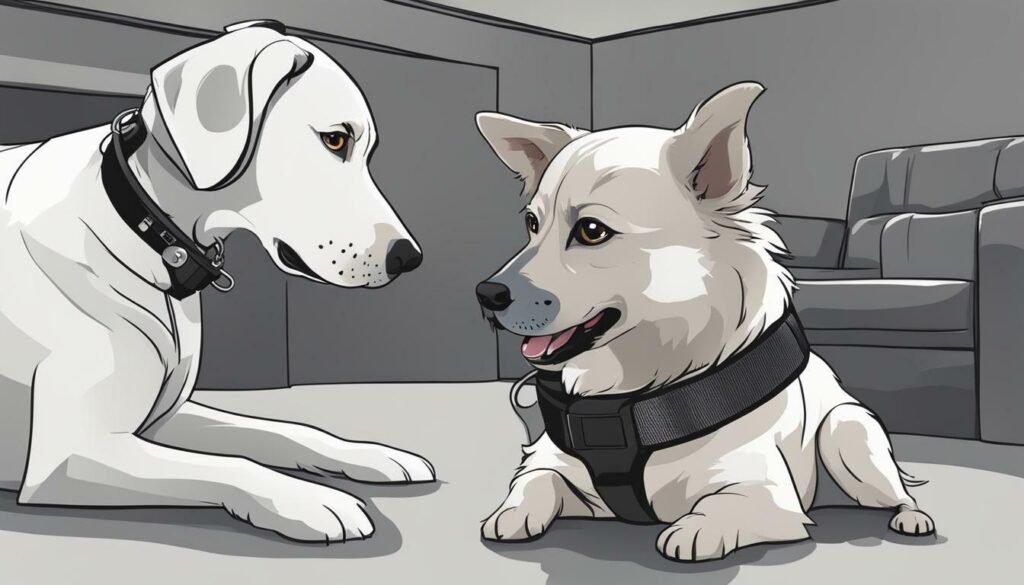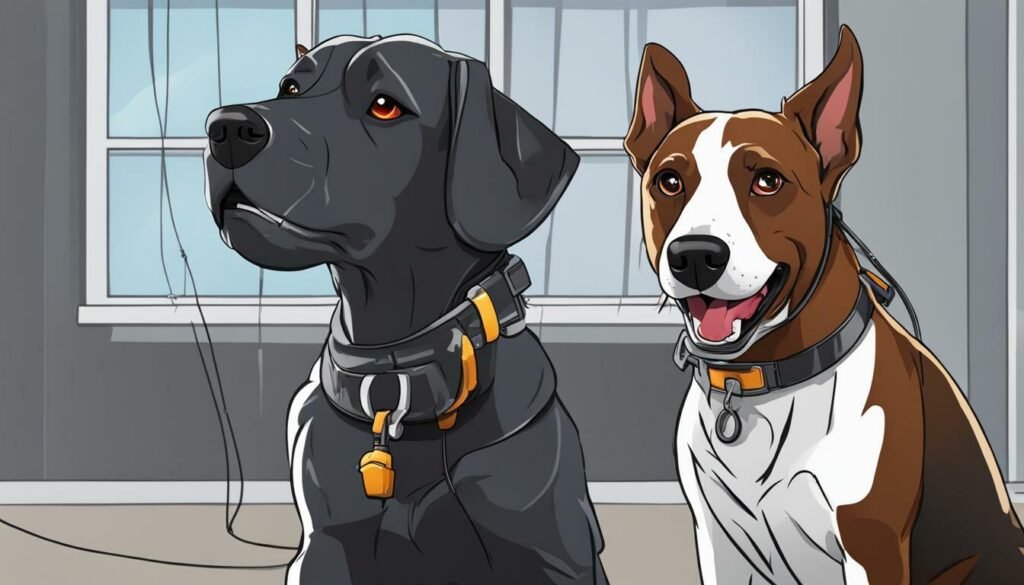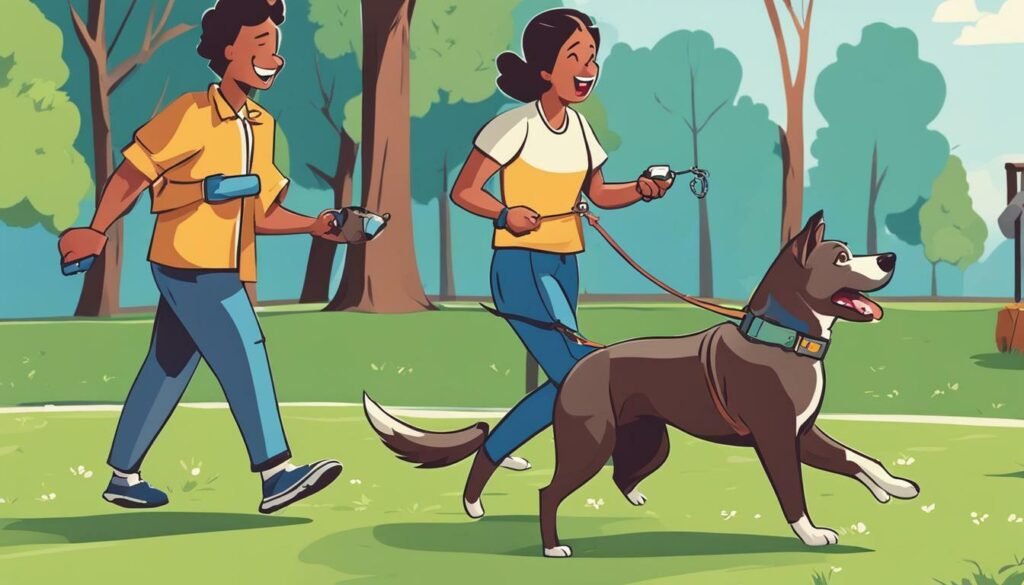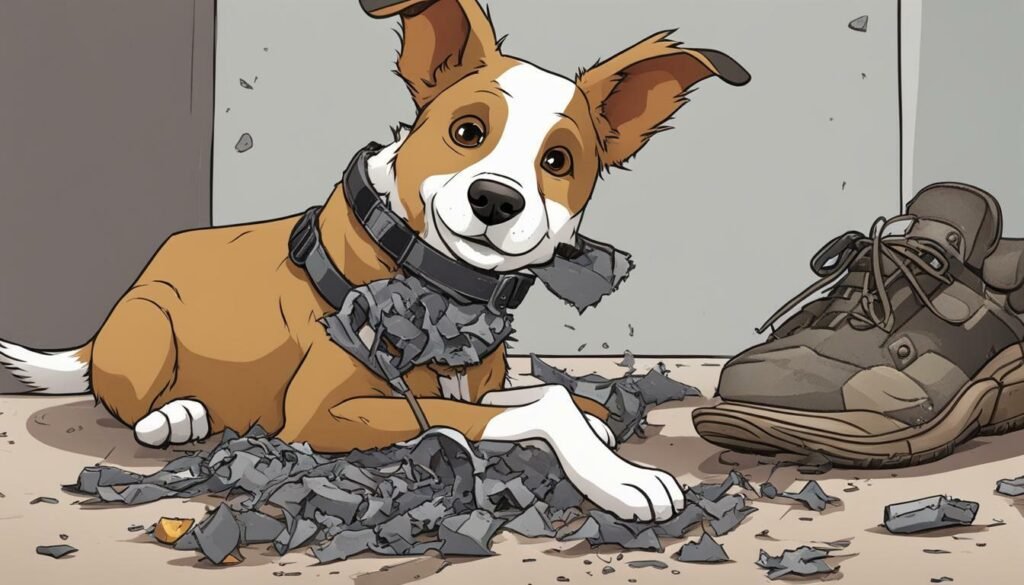Training your dog can be a fun and rewarding experience, but it can also be challenging, especially if your dog is particularly stubborn or difficult to train. One effective method of dog training is through the use of a shock collar, which can help to correct undesirable behaviors and reinforce positive habits.
In this article, we will guide you through the steps and techniques to train your dog with a shock collar safely and effectively. We will also discuss the benefits of using a shock collar for obedience training and highlight the best methods, tips, and tricks.

Key Takeaways
- Training your dog with a shock collar can be an effective method for correcting undesirable behaviors.
- Before using a shock collar, it’s important to understand how they work and the different types available.
- Proper preparation, clear training objectives, and positive reinforcement are essential for successful shock collar training.
- Shock collars can be used to teach basic commands and address common behavioral issues.
- Gradually advancing training techniques can keep your dog engaged and help them to progress.
Is It Okay to Train your dog with a shock collar -Understanding Shock Collars
If you want to use a shock or an electronic collar for your dog training, it’s important to first learn how to use these dog training tool and how these training devices work, what types are available, which will be best for your dog training and pros and cons of using these electronic training collars.
Shock collars works to deliver an electric shock to your dog’s neck when triggered by a remote control, which can be used to communicate commands or discourage unwanted behavior.

Though shock collars may seem like a harsh training method, but when used correctly and responsibly, these tools can be effective for reinforcing positive behavior. However, it’s crucial to use the lowest level of shock necessary and to never use the collar as punishment.
There are three main types of shock collars:
- Static shock collars: These collars deliver a brief, low-intensity shock to your dog’s neck when triggered.
- Vibration collars: These collars use a non-electrical vibration to communicate with your dog and can be a good alternative to static shock collars for more sensitive dogs.
- Spray collars: These collars spray a scent or mist when triggered, which can discourage barking or other unwanted behavior.
How to choose Best Dog Training Collar for Your Dog Training
Choosing the right shock collar for your dog is crucial to ensure your dog safety and effective training. With so many options available on the market, it can be daunting to make a decision. Here are some factors to consider when selecting a shock collar:
| Factor | Description |
|---|---|
| Size and weight | The shock collar should fit your dog comfortably without causing any discomfort. It should not be too heavy or too loose. |
| Type of stimulation | Different shock collars offer varying types of stimulation, ranging from a static shock, vibration, or a beep. Choose the type that works best for your dog’s needs and personality. |
| Range | Determine the distance at which you plan to use the collar and choose one with an appropriate range. |
| Battery life | Consider the battery life of the collar and how long it will last without needing to be recharged or replaced. |
| Water resistance | If your dog enjoys swimming or playing in the rain, consider a shock collar that is water-resistant or waterproof. |

Though shock collars may seem like a harsh training method, when used correctly and responsibly, they can be an effective tool for reinforcing positive behavior.
Preparing Your Dog for Shock Collar Training
Before using a shock collar to train your dog, it’s important to take the necessary steps to ensure a positive and safe experience for your furry friend. Before introducing the collar, it’s essential to prepare your dog both mentally and physically.
Introduce the Collar Slowly
When introducing the shock collar to your dog, take it slow. Let your dog sniff the collar and get familiar with it before putting it on. Once your dog seem comfortable with the collar, attach it to your dog’s neck and make sure it’s properly fitted, with enough room to fit two fingers between the collar and their skin.
It’s important to note that shock collars should only be used on dogs who are over six months old and have received basic obedience training.
Establish a Positive Association with the Collar
Before using the shock collar for training purposes, establish a positive association with it. This can be achieved by giving your dog treats or praise every time you put the dog collar on or take it off. By doing this, your dog will start to associate the training collar with positive experiences, making your dog more receptive to the training process.
Ensure Your Dog is Healthy and Fit for Training
Before starting any kind of training, it’s important to make sure your dog is healthy and fit. Take your dog to the vet for a check-up and make sure that your dog is up-to-date on all vaccinations. If your dog has any health issues, consult with your vet before using a shock collar for training.

By taking these preparatory steps, you can ensure that your dog is comfortable and ready for shock collar training. Remember, it’s important to use the training collar responsibly and always with your dog’s best interests in mind.
How to Properly Train a Dog using a Shock Collar
Before starting shock collar training, it’s crucial to set clear and specific training objectives. This will help you achieve your training goals effectively and efficiently.
Identify specific goals: Determine what behaviors or commands you want your dog to learn or correct with the shock collar. Write down your objectives, and make sure they are realistic and achievable within a reasonable time frame.
Establish priorities: Decide which training goals are most important for your dog’s safety and well-being. For example, if your dog has a tendency to run off-leash, teaching your dog to come when called should be a top priority.
Develop a training plan: Create a step-by-step plan with specific activities and exercises that will support your training objectives. This plan should include how often you will conduct training sessions, the duration of each session, and any equipment or tools you will need.
One important thing to keep in mind is to avoid overwhelming your dog with too many objectives at once. We will suggest you to focus on one behavior or command at a time that will improve training results and this will also reduce anxiety in your dog. As you and your dog make progress, you can gradually introduce more goals and more complex training exercises.

Remember, clear training objectives are critical to successful shock collar training. By setting realistic goals, establishing priorities, and developing a training plan, you can achieve remarkable results through this training technique.
How You Can Teach Your Dog Basic Commands using a Shock Collar
Once your dog is comfortable wearing the shock collar, it’s time to start introducing basic obedience commands. Remember to always use positive reinforcement alongside the collar to reinforce good behavior. Here are the steps to teach your dog basic commands using the shock collar:
Sit: Start by placing your dog in a sitting position. Hold a treat above their head and move it backward while saying “sit.” As your dog lowers their body, press the collar’s remote button to emit a mild shock. Release the button as soon as your dog completes the command. Reward your dog with the treat and praise your dog for their good work. Practice regularly until your dog can sit on command without a treat in sight.
Stay: Once your dog has mastered the sit command, you can move on to teaching your dog to stay. Start by commanding your dog to sit, then take a step back. If your dog stays in place, reward your dog with a treat and praise. If your dog move, use the shock collar to remind your dog of the command, and repeat the process. Gradually increase the distance between you and your dog as your dog get used to the command.
Come: The come command is crucial for keeping your dog safe in emergency situations. Start by attaching a long leash to your dog’s collar and let your dog wander a short distance away. Call your dog’s name followed by the “come” command and pull the leash gently towards you. As your dog moves towards you, press the shock collar’s remote button and release it as soon as your dog reaches you. Reward your dog with a treat and praise for a job well done. Gradually increase the distance between you and your dog as your dog become more comfortable with the command.
Heel: Walking your dog on a leash is much more enjoyable when your dog is well-behaved. To teach your dog the heel command, start by attaching a leash to their collar and walk your dog in a quiet area with minimal distractions. Hold the leash firmly and use the shock collar to correct any pulling or misbehavior. As you walk, say “heel” in a firm, commanding tone. Reward your dog with treats and praise for good behavior.

Remember to take things slowly and be patient with your dog as your dog learning these commands. Consistency and practice is important, your dog will get the hang of it in no time! To help you visualize the process of teaching your dog basic commands with a shock collar.
How to use a Shock Collar to Correct Bad Behaviors in Your Dog
Shock collars can be especially effective for correcting common behavioral issues in dogs, such as excessive barking, jumping, and pulling on the leash. However, it’s important to identify the root cause of the behavior before using the shock collar.
For instance, if your dog is barking excessively due to separation anxiety, using a shock collar will not address the underlying problem and can actually make the behavior worse. In such cases, we recommend seeking professional help or alternative training methods.
When using a shock collar to correct behavioral issues, it’s important to remain patient and consistent. Start by setting clear objectives and prioritizing the behaviors you want to correct. Then, use the shock collar with positive reinforcement techniques, such as verbal praise and treats, to modify your dog’s behavior gradually.
If your dog is jumping on people or pulling on the leash, use the shock collar to interrupt the behavior and redirect your dog’s attention to a more appropriate behavior, such as sitting or walking calmly. With consistent training, your dog will learn to associate the shock with the unwanted behavior and begin to exhibit more desirable behaviors.

However, it’s important to remember that the shock collar should only be used as a last resort and with positive reinforcement techniques. Using the collar excessively or inappropriately can cause physical and emotional harm to your dog and damage your relationship with your furry friend.
Advance Dog Training Steps using a Shock Collar
As your dog becomes more comfortable with the shock collar, it’s important to gradually increase the difficulty level of commands and introduce more complex training exercises. This helps to keep your dog engaged and challenged, which can lead to faster and more effective results.
One way to advance your dog’s training is to increase the distance between you and your dog when giving commands. Start by standing close to your dog, and gradually move further away as your dog become more confident in following commands.
You can also introduce distractions, such as toys or other dogs, to test your dog’s focus and obedience. Start with minor distractions and gradually increase the level of difficulty as your dog improves.
Another way to advance your dog’s training is to introduce new commands and exercises. For example, you can teach your dog to retrieve objects, jump over obstacles, or perform tricks like rolling over or playing dead. Be creative and have fun with your dog while training him/her.

Remember to always use positive reinforcement alongside the shock collar. Praise your dog for good behavior and give your dog treats as a reward. This helps to build a strong bond between you and your dog and encourages your dog to continue learning and improving.
By gradually advancing your training techniques, you can help your dog reach their full potential and become a well-behaved and obedient companion. With patience, consistency, and love, you can achieve great results with shock collar training.
Final Thought
Training your dog with a shock collar can be a highly effective way to teach basic commands and correct unwanted behaviors. However, it’s crucial to use this training method responsibly and with your dog’s wellbeing in mind.
Remember to prepare your dog properly before starting shock collar training, and always use the collar in conjunction with positive reinforcement techniques. Be patient and consistent with your training, and don’t hesitate to seek professional help if needed.
As you and your dog progress in your training, keep advancing the techniques to keep your dog engage and challenged. Always prioritize the safety and comfort of your furry friend, and remember to shower your dog with love and affection throughout the training process.
With these tips and strategies, you can successfully train your dog with a shock collar in easy steps. We hope this guide has provided you with valuable insights and empowered you to become a confident and responsible pet owner.

